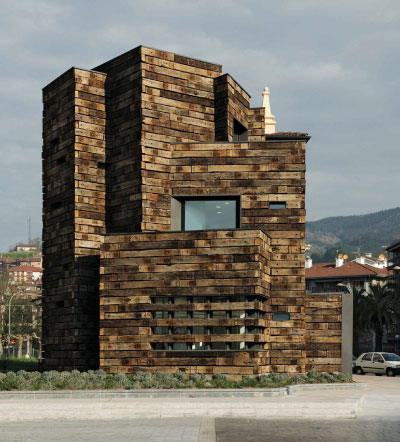
Azkoitia Municipal Library, Gipuzcoa, Spain, 2007. Estudio Beldarrain.
Facade built from railroad ties.
All images courtesy of W.W. Norton. (Click images to enlarge)
Short of building nothing new at all, the most environmentally-conscious strategy toward construction is to build with what materials are at hand. This reduces the extent of mining and foresting, the energy required for fabrication, and the emissions associated with shipping.
One powerful and increasingly popular approach is to build with waste materials. This can be implemented at different scales, by powdering demolished concrete blocks to use in a new mix, building a house on an old foundation, or reinvigorating an abandoned site like Governor’s Island. Alejandro Bahamon and Maria Camila Sanjines have compiled some of the more promising waste-capturing projects in an inspiring new book, Rematerial: From Waste to Architecture.
The projects have a distinct aesthetic, one that values the patina of weathered and marred materials over refined geometries and gleaming surfaces. A small library in Spain, whose walls are constructed from stacked railroad ties, has a rough, mottled appearance. A house addition in The Hague, with a facade of tread-worn tires, has a post-apocalyptic, Mad Max look.




 Facebook
Facebook Permalink
Permalink Digg
Digg Reddit
Reddit LinkedIn
LinkedIn StumbleUpon
StumbleUpon Tumblr
Tumblr

